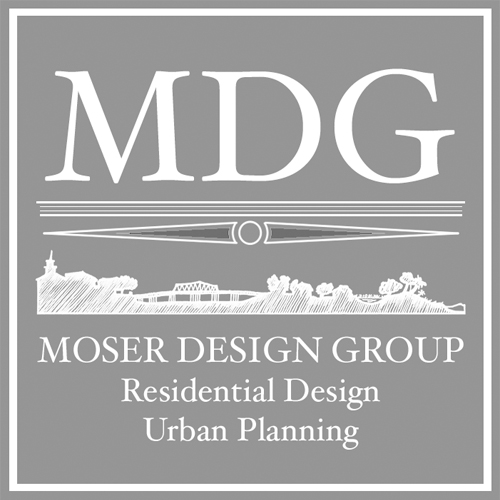Alternative Development Planning - Benefits of Traditional Neighborhood Development
Our team at Moser Design Group recently collaborated with the Coastal Conservation League to compile an alternative development plan to the sprawl-based models proposed by large-scale developers in Ridgeville, SC. Although it was created with coastal SC in mind, it is an approach that can be applied to similar projects to ensure a deep level of intentionality - and it is an approach that we integrate frequently as a firm. This alternative development approach is proven to have several quantifiable and tangential benefits over the typical suburban sprawl model:
1. Reduced Infrastructure Costs
TNDs are proven to have lower upfront infrastructure costs than sprawling developments.
This is because there are fewer linear feet of streets and driveways when lots are smaller and alleys run behind many of the houses.
TNDs tend to lay more lightly on the land, meaning that they are not clear-cut, stripped of all existing trees and vegetation, and re-graded into building pads. Thus there is less cut and fill, and the natural drainage patterns that exist pre-development can be incorporated into the overall stormwater management system. This can reduce the amount of stormwater infrastructure required as well.
A 2013 Smart Growth America Report entitled “Building Better Budgets, A National Examination of the Fiscal Benefits of Smart Growth Development” estimates the cost savings of infrastructure installation to be 38-50%. Long-term maintenance savings have also been tracked to be similarly less expensive.
This same study estimates the ongoing servicing of these types of developments from fire, police, ambulance, trash, and other municipal services to be at least 10% less than sprawling developments.
2. Market Flexibility & Unit Diversity
TNDs have interconnected streets with opportunities for a diversity of lot sizes and building types within a single street or block.
This opportunity for choice broadens the market range. Within one new TND, there can be many types of housing including large houses, cottages, duplexes and triplexes, 4-12 unit buildings that function as condos and/or apartments, townhouses, live-works, and accessory dwelling units.
The size range can be from 400-3,000+ heated square feet. This tremendously diversifies the pool of potential buyers and renters.
Within each transect zone, a smaller subset of building types is permitted. This allows the developer to easily adapt to changing market conditions by adjusting housing types mid-stream. Contrast this to a single-size subdivision pod, where all of the lots are platted for a mono-culture of housing types and sizes - if the market demands something different, it is very difficult to pivot.
This broad range of housing retains residents because it offers choices to accommodate a variety of living situations, from single people to growing families, to downsizing empty-nesters, to folks wanting to age in place.
The TND model also allows for easier future expansion since the network of streets is naturally interconnected.
3. Built-in Amenities
TNDs have areas that incorporate neighborhood-serving commercial uses along with residential units. These commercial uses can include food and beverage offerings such as restaurants and coffee shops, retail such as general stores and other specialty shops, and services such as dentist offices and hair salons. Office space is also typically incorporated in these more urban districts.
The town center - the place where these commercial uses are mixed in with and are often below, residential units - becomes the main amenity. Other conventional amenities, such as pools, playgrounds, and golf courses, become secondary, if they even are included at all.
Lots in TNDs command a premium compared to typical sprawl developments and tend to retain their value in economic downturns. See “An Empirical Examination of Traditional Neighborhood Development” published by Marquette University.
The upfront cost of homeownership, based on the amenity of a TND, is quickly offset to the owner by the reduction of the annual cost to live in TNDs due to smaller houses and yard maintenance, and fewer vehicle miles traveled.
Stormwater management also becomes an amenity by weaving in meaningful, active, and usable greenspace - that includes stormwater retention and detention and treatment solutions - into and throughout the neighborhood. When more lots and households have access to shared common spaces, value is increased in every lot rather than on only the lots with direct access when greenspace and common spaces are privatized or put behind houses.
Stormwater, following this model, does double duty as an amenity thus reducing infrastructure costs and redundancies, and building internal value.
4. Creating Real Community
All of these 3 items - more connected and compact infrastructure, a diversity of housing types and lot sizes, and having authentic amenities such as a town center and usable greenspace - naturally foster community.
Providing safe ways to travel multi-modally through a neighborhood activates streets and also has tremendous health impacts. This has been studied by the NIH numerous from both a physical and emotional well-being standpoint.
Providing a variety of uses within a walkable framework reduces the number of vehicle miles traveled, thus reducing greenhouse gas emissions while allowing residents to stay within their neighborhood for more daily needs and services. This naturally fosters community building.
Having cohesive town centers where residents and those who live adjacent can have many of their daily needs met boosts the local economy while providing opportunities for chance encounters that foster social interaction.
Interconnecting streets, greenspaces, civic spaces, and trail networks within the new neighborhoods and into the existing infrastructure of Ridgeville provides a natural linkage between new and old, and eventually creates a seamless connection. It allows the existing town and residents to benefit from new development and in turn, often leads to reinvestment in and expansion of existing downtown businesses.
